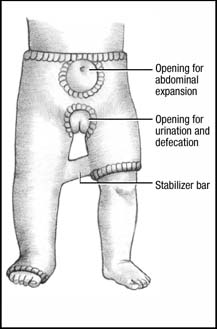Hip-spica cast care
Description
Used to immobilize a child’s legs after orthopedic surgery to correct a fracture or deformity, and sometimes used to treat an orthopedic deformity that doesn’t require surgery
Poses several challenges regarding care, including protecting the cast from urine and feces, keeping the cast dry, ensuring proper blood supply to the legs, and teaching the child and his parents how to care for the cast at home
Infants usually more adaptable to the cast than older children; but both needing encouragement, support, and diversionary activity during their prolonged immobilization
Understanding the hip-spica cast
As you talk with parents about their child’s hip-spica cast, describe how it will extend from the child’s lower rib margin (or sometimes from the nipple line) down to the tips of the toes on the affected side and to the knee on the opposite, unaffected side. Mention that it expands at the waist to allow the child to eat comfortably. A stabilizer bar positioned between the legs keeps the hips in slight abduction and separates the legs.
 |
Equipment
Waterproof adhesive tape ♦ moleskin or plastic petals ♦cast cutter or saw ♦ scissors ♦ nonabrasive cleaner ♦blow-dryer ♦ optional: disposable diaper or perineal pad
Essential steps
Before the physician applies the cast, describe the procedure to the child and his parents.
For children ages 3 to 12, illustrate your explanation. Draw a picture, present a diagram, or use a doll with a cast or elastic gauze dressing wrapped around its trunk and limbs. (See Understanding the hip-spica cast.)
Stay updated, free articles. Join our Telegram channel

Full access? Get Clinical Tree


